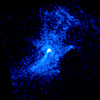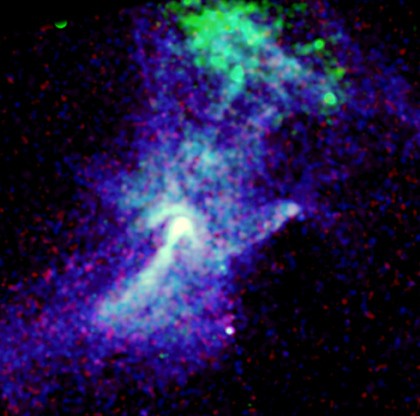Chandra Examines A Quadrillion-volt Pulsar
This Chandra image gave astronomers their first view of the energetic and complex nebula surrounding the young pulsar PSR B1509-58. The blue and purple colors indicate X-rays emitted by high-energy particles of matter and anti-matter which stream away from the pulsar. The pulsar itself is the bright white source at the center of the nebula.
A thin jet, almost 20 light years in length, extends to the lower left, and traces a beam of particles being shot out from the pulsar's south pole at more than 130 million miles per hour. Just above the pulsar can be seen a small arc of X-ray emission, which marks a shock wave produced by particles flowing away from the pulsar's equator.
The green cloud near the top of the image is due to multimillion degree Celsius gas. This gas, possibly a remnant of the supernova explosion associated with the creation of the pulsar, may have been heated by collisions with high-energy particles produced by the pulsar.
|
||||||||||||||||||||||||||
This X-ray image is of a neutron star and its surrounding nebula called SNR G320.4-1.2, which is a remnant of a supernova explosion that occurred in the Milky Way. The image shows a purple and green object with some blue and red spots around it, in the shape of a large cosmic hand. Neutron stars are among the densest known objects in the universe, with a mass greater than that of the sun compressed into an object only about 10 kilometers (6 miles) in diameter. They are formed when a massive star undergoes a supernova explosion, leaving behind a dense core composed primarily of neutrons. The blue and purple colors indicate X-rays emitted by high-energy particles of matter and anti-matter which stream away from the pulsar. The pulsar itself is the bright white source at the center of the nebula. A thin jet, almost 20 light years in length, extends to the lower left, and traces a beam of particles being shot out from the pulsar's south pole at more than 130 million miles per hour. Just above the pulsar is a small arc of X-ray emission, which marks a shock wave produced by particles flowing away from the pulsar's equator. The green cloud near the top of the image is due to multimillion degree Celsius gas. This gas, possibly a remnant of the supernova explosion associated with the creation of the pulsar, may have been heated by collisions with high-energy particles produced by the pulsar.





